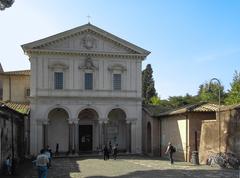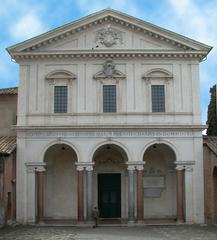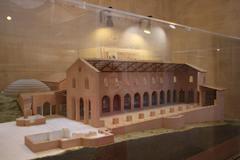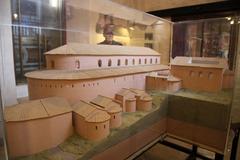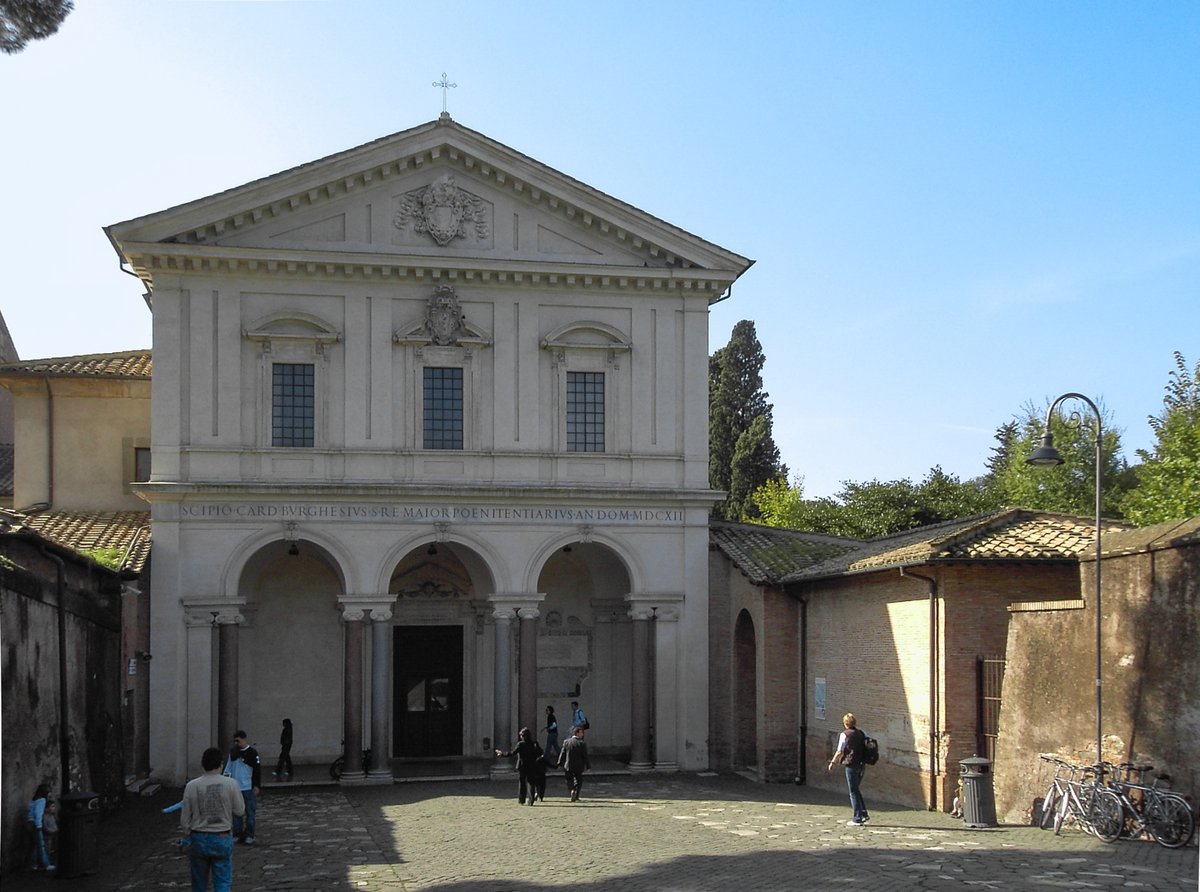
San Sebastiano Fuori Le Mura: Comprehensive Guide to Visiting Hours, Tickets, and Historical Insights
Date: 14/06/2025
Introduction
San Sebastiano Fuori Le Mura, or Saint Sebastian Outside the Walls, is one of Rome’s most revered pilgrimage basilicas, known for its deep Christian roots, remarkable art, and the ancient catacombs beneath its foundation. Located along the historic Via Appia Antica, this basilica offers an immersive journey into the origins of Christian Rome, the cult of martyrs, and centuries of artistic evolution. Whether you are a pilgrim, history enthusiast, or a traveler seeking Rome’s hidden gems, this guide presents everything you need to plan your visit, including updated hours, ticketing, accessibility, key artworks, and details on special events like the 2025 Jubilee (Wikipedia; Iubilaeum 2025; Turismo Roma).
Historical Overview
Early Christian Origins
San Sebastiano Fuori Le Mura stands on a site that transitioned from a pagan quarry and necropolis to a sacred Christian burial ground in the early 4th century CE, under Emperor Constantine. Its catacombs are some of Rome’s oldest, stretching over 12 kilometers and comprising multiple underground levels. The basilica was constructed above these burial tunnels, marking the area as a focal point for early Christian worship and martyr commemoration (Turismo Roma; Pilgrimaps).
Connection to Saints Peter and Paul
Before its dedication to Saint Sebastian, the basilica was known as the Basilica Apostolorum. Christian tradition recounts that the relics of Saints Peter and Paul were hidden here during 3rd-century persecutions, elevating the site as a symbol of faith and resilience (Iubilaeum 2025).
Saint Sebastian and the Basilica’s Patronage
The basilica is named for Saint Sebastian, a Roman soldier and Christian martyr, whose body was interred in the catacombs below. His veneration as a protector against plagues further enhanced the basilica’s role as a destination for pilgrims seeking healing and spiritual intercession (Audiala).
Medieval and Baroque Transformations
After suffering damage and the temporary relocation of Saint Sebastian’s relics during Saracen raids, the basilica was rebuilt and expanded through the Middle Ages and Renaissance. In the early 17th century, Cardinal Scipione Borghese commissioned a significant Baroque restoration, with architects Flaminio Ponzio and Giovanni Vasanzio redefining the basilica’s appearance (Pilgrimaps; Turismo Roma).
Architectural and Artistic Highlights
Exterior and Courtyard
San Sebastiano features a dignified Baroque façade and a tranquil courtyard, offering visitors a peaceful prelude to the basilica’s interior. The porticoed entrance and surrounding remnants of ancient Roman structures highlight its location “fuori le mura” (outside the walls) (Liturgical Arts Journal).
Interior Layout
- Nave and Aisles: The basilica’s nave is lined with columns, some reused from earlier Roman buildings, leading to chapels housing devotional artworks and relics.
- Ceiling: The coffered wooden ceiling, a masterpiece of the Baroque restoration, features gilded decorations and a central painting of Saint Sebastian’s martyrdom.
- Main Altar and Apse: The apse contains the main altar with a marble baldachin and art depicting Christ, the Virgin, and Saint Sebastian. Beneath lies the crypt, believed to be the original burial site of the saint.
- Chapels: The Chapel of Relics displays items linked to Saint Sebastian’s martyrdom, including an arrow and the column fragment. The Chapel of Saint Sebastian features a statue by Antonio Giorgetti, designed by Gian Lorenzo Bernini. The Albani Chapel is notable for its early 18th-century art.
Notable Artworks
- Bernini’s “Salvator Mundi”: A marble bust attributed to Gian Lorenzo Bernini.
- Ancient Mosaics and Frescoes: Fragments preserved in the apse and crypt, reflecting early Christian artistry (Pilgrimaps; Rome Sightseeing).
The Catacombs of San Sebastiano
Historical Importance
Dating from the late 2nd and early 3rd centuries, the Catacombs of San Sebastiano are among the most significant Christian burial complexes in Rome. The term “catacomb” itself is believed to derive from this site (Turismo Roma; iubilaeum2025.va).
What to See
- Ancient Burial Chambers: Loculi, arcosolia, and frescoed cubicula illustrating early Christian funerary customs.
- Pagan Mausolea: Three mausolea repurposed by Christians, marking the shift from pagan to Christian burial practices.
- Early Christian Graffiti: Inscriptions and invocations honoring Saints Peter and Paul.
- The Cubicle of Jonah: 4th-century frescoes symbolizing resurrection and hope.
Guided tours, mandatory for entry, offer expert explanations and last about 30–40 minutes (thebettervacation.com; toorists.com).
Visiting Hours, Tickets, and Access
Basilica Visiting Hours
- Monday to Saturday: 9:00 AM – 12:00 PM and 3:00 PM – 6:00 PM
- Sundays and Public Holidays: 9:00 AM – 1:00 PM
- Alternative Schedule: Some sources list 8:00 AM – 1:00 PM and 2:00 PM – 5:30 PM (HelloMondo; Catholic Shrine Basilica)
Hours may vary seasonally or during special events. Always check the official website or call ahead.
Catacomb Visiting Hours
- Daily: 10:00 AM – 5:00 PM (last entry 4:30 PM)
- Closed: December 25, January 1, and Easter Day (thebettervacation.com)
Tickets and Guided Tours
- Basilica: Free entry.
- Catacombs: Guided tour required; tickets €8–15 for adults, discounts for children, students, and priests. Tours in Italian, English, French, German, and Spanish (toorists.com; Tickets Rome).
- Advance Booking: Strongly recommended, especially during Jubilee years.
Accessibility
- Basilica: Wheelchair accessible.
- Catacombs: Not wheelchair accessible due to stairs and narrow passages. Visitors with mobility issues should inquire before arrival.
Getting There
- By Bus: 118 or 218 from central Rome, stops near the basilica.
- By Metro: Line B to Piramide, then connecting bus.
- By Car: Limited parking available; public transport is recommended.
Religious Services and Special Events
- Mass Schedule: Monday–Friday at 6:00 PM. Saturday and Sunday at 8:30 AM, 10:00 AM, and 12:00 PM.
- Feast of Saint Sebastian: January 20th, with special liturgies attracting pilgrims worldwide (San Sebastiano FLM).
- Jubilee Year Activities: Special catechesis, confessions, and prayer events for pilgrims in 2025 (Iubilaeum 2025).
Pilgrimage and the Jubilee
San Sebastiano Fuori Le Mura is one of the Seven Pilgrim Churches of Rome, central to the traditional pilgrimage route revived by Saint Philip Neri in the 16th century. During jubilees, such as 2025, the basilica and its catacombs become focal points for spiritual renewal, indulgences, and organized pilgrimage events (rome-tourism.org). Special services and the opening of the Holy Door are integral to the Jubilee pilgrimage experience.
Practical Visitor Tips
- Best Time to Visit: Early mornings or late afternoons for peaceful exploration and optimal photography (HelloMondo).
- Dress Code: Modest attire covering shoulders and knees is required.
- Photography: Permitted inside the basilica (no flash); strictly prohibited in the catacombs.
- Facilities: Restrooms, gift shop, and nearby cafes.
- Visitor Conduct: Maintain silence and respect, especially during liturgies and in sacred spaces.
- Contact: +06 45430260 for group bookings or specific inquiries (Catholic Shrine Basilica).
- Language Support: Information and tours available in multiple languages; audio guides may be available for rent.
Nearby Attractions
Explore the historic Via Appia Antica, including the Catacombs of San Callisto, Tomb of Cecilia Metella, and the Parco Regionale dell’Appia Antica. These sites are ideal for walking or cycling tours, offering a broader context to Rome’s early Christian and imperial history (HelloMondo).
Frequently Asked Questions (FAQ)
Q: What are the basilica and catacomb visiting hours?
A: Basilica: 9:00 AM–12:00 PM & 3:00 PM–6:00 PM (see notes above). Catacombs: 10:00 AM–5:00 PM, last entry 4:30 PM.
Q: Is there an entry fee?
A: Basilica entry is free; catacomb tours require a ticket.
Q: Are guided tours available in English?
A: Yes, guided tours for the catacombs are offered in English and other major languages.
Q: Are the catacombs accessible for wheelchairs?
A: No, due to narrow and uneven passages.
Q: Can I take photographs?
A: Photography is allowed in the basilica without flash. No photography in the catacombs.
Q: How can I reach San Sebastiano Fuori Le Mura?
A: By bus (118, 218), metro (Line B to Piramide, then bus), or car (limited parking).
Conclusion
San Sebastiano Fuori Le Mura is a living testament to Rome’s Christian heritage, offering visitors a unique blend of spiritual depth, artistic treasures, and historical resonance. Its catacombs and basilica narrate the story of early Christian faith and resilience, while ongoing religious life and Jubilee celebrations connect past and present. For an enriching and well-prepared visit, confirm current hours, book tours ahead, and consider attending special events during Jubilee years.
Enhance your experience with the Audiala app for guided audio tours and expert tips. Follow us on social media for the latest updates and explore our related posts on Rome’s historical treasures.
